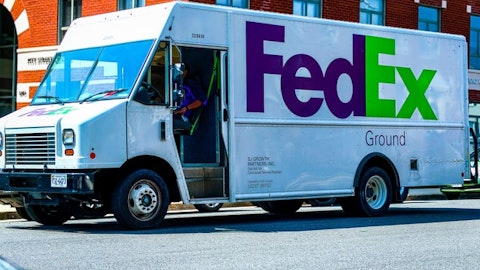FedEx Corporation (NYSE:FDX) Q3 2024 Earnings Call Transcript March 21, 2024
FedEx Corporation misses on earnings expectations. Reported EPS is $ EPS, expectations were $3.49. FDX isn’t one of the 30 most popular stocks among hedge funds at the end of the third quarter (see the details here).
Operator: Good day. And welcome to the FedEx Fiscal Year 2024 Third Quarter Earnings Call. All participants are in listen-only mode [Operator Instructions]. After today’s presentation, there will be an opportunity to ask questions [Operator Instructions]. Please note, this event is being recorded. I would now like to turn the conference over to Jeni Hollander, Vice President of Investor Relations. Please go ahead.
Jeni Hollander: Good afternoon. And welcome to FedEx Corporation’s third quarter earnings conference call. The third quarter earnings release, Form 10-Q, and stat book are on our Web site at investors.fedex.com. This call and the accompanying slides are being streamed from our website where the replay and slides will be available for about one year. During our Q&A session, callers will be limited to one question to allow us to accommodate all those who would like to participate. Certain statements in this conference call may be considered forward-looking statements as defined in the Private Securities Litigation Reform Act of 1995. Such forward-looking statements are subject to risks, uncertainties and other factors that could cause actual results to differ materially from those expressed or implied by such forward-looking statements.
For additional information on these factors, please refer to our press releases and filings with the SEC. Today’s presentation also include certain non-GAAP financial measures. Please refer to the Investor Relations portion of our website at fedex.com for a reconciliation of the non-GAAP financial measures discussed on this call to the most directly comparable GAAP measures. Joining us on the call today are Raj Subramaniam, President and CEO; Brie Carere, Executive Vice President, Chief Customer Officer; and John Dietrich, Executive Vice President and CFO. Now, I will turn it over to Raj.
Raj Subramaniam: Thank you, Jeni, and welcome to your first earnings call at FedEx. We’re happy to have you on board leading the Investor Relations team. Before we discuss the quarter, I would like to congratulate Bob Carter on his upcoming retirement, which we announced last week. He has served as CIO for the last 24 years, leading FedEx in modernizing our IT infrastructure. I’m immensely grateful to Rob for his numerous contributions in establishing FedEx as an innovative, data driven and a people focused company. We thank him for his dedication and service to FedEx over the years and wish him well in his upcoming retirement. Thank you also to the FedEx team for their exceptional work in Q3 by providing superior service for customers and delivering strong results, all while advancing our transformation initiatives.
For the third consecutive quarter, we delivered operating income growth and margin expansion in a declining revenue environment. This is a very positive dynamic and a unique one in our industry. It demonstrates clear progress on our transformation and ability to manage what’s within our control through DRIVE. We’re strengthening our value proposition, improving the customer experience and increasing profitability. This progress supports our long-term goals for sustainable margin expansion, improvements in ROIC and value creation for our stockholders. Now turning to the details. Our transformation is driving continued improvements in adjusted operating income, margins and earnings per share. At the enterprise level, we delivered a 16% improvement in adjusted operating income and adjusted margin expansion of 90 basis points compared to the prior year even as revenue declined 2%.
Adjusted operating income growth was driven by continued strength at Ground and improvement at Express. At the segment level, I’m particularly pleased with the results at Ground where adjusted operating income increased 14% on 1% revenue growth and adjusted operating margin improved to over 11% in the quarter. This reflects continued progress controlling expenses and effective yield management, including the ramping benefits from DRIVE. At Freight, the team’s continued focus on profitable growth and cost management delivered strong margins and mitigated year-over-year volume challenges. Service levels remain exceptionally high, demonstrating our differentiated execution capabilities. We’re also making progress at Express where adjusted operating income increase enabled by our ability to remove structural costs.
Looking ahead, we are reaffirming the midpoint of our fiscal ’24 adjusted EPS range while narrowing the range to $17.25 to $18.25. In fact, we now expect to deliver adjusted earnings above the midpoint of the range we shared last June despite full year revenue expectations that have deteriorated significantly over the past nine months. This is clear evidence of our ability to execute. Turning to the Express business. It is my top priority to continue to make the changes necessary to align our air network with an evolving demand environment and unlock the full profit opportunity. While we have made progress at Express this quarter, there are several areas we’re aggressively working to address in order to accelerate profit improvement; service mix, network utilization, continued inflation and other cost headwinds.
First with respect to service mix. We’re seeing a clear international market shift towards deferred services. This is tied in part to the rapid growth of many of our e-commerce customers where we are a critical enabler of global trade offering unique solutions for our customers. More on how we are addressing this mix shift shortly. Second, weakness in global trade continues to constrain demand in our international business, which has remained challenged for longer than expected. As such, we’re continuing to proactively realign our air network to match capacity to demand. And third, this quarter express experienced over $200 million of inflationary pressure on a year-over-year basis. We offset this with benefits from DRIVE, as well as responsible headcount management.
The dynamics I just outlined create significant opportunities for us to improve our network utilization. Last quarter, we introduced our Tricolor strategy. Ultimately, this network design will enable us to improve the efficiency and asset utilization of the entire FedEx system; put the right product in the right network, taking advantage of our continental surface networks in Europe and our market leading FedEx Freight LTL network in the United States; and profitably penetrate new market segments at the right cost structure, including the premium airfreight market. As we move forward, we are managing the execution of Tricolor with the rigor and discipline of DRIVE and this will be a key element to our success. Moving to another area of opportunity.
In Europe, we continue to improve our service levels and focus on commercial execution. However, the B2B environment remains challenged. And in this context, we are making progress on DRIVE on track to generate $600 million of savings in fiscal year 2025 and seeking further profit optimization opportunities. As we have mentioned in previous calls, we are also experiencing a continued headwind for the United States Postal Service, which has reduced volume. Despite this volume and revenue draw down, our service obligations to the USPS remain fixed. Express and across the business, DRIVE remains a key enabler of improved profitability both in the near and the long term as we change the way we work and identify areas for structural cost reduction.
In Q3, we delivered $550 million of benefits from DRIVE, offsetting the impact of revenue declines and cost pressures. I’m encouraged by the progress across all three categories. This includes $290 million in our surface network, $110 million of savings in air network and international operations, and $150 million of G&A. Given the progress we have made year-to-date, we will deliver on our goal of $1.8 billion in permanent cost reduction benefits from DRIVE this fiscal year and are highly confident on the additional $2.2 billion in fiscal year ’25. The work we are doing with DRIVE is also helping advance planning for Network 2.0. This quarter, we rolled out our new surface operations leadership structure. Under this new structure, leaders and their teams will be responsible for all Express and Ground package operations and facilities in their respective divisions, regions and districts.
This for enhance operational execution and offer greater insights into the package business overall with accountability at all levels. More broadly, we have now implemented Network 2.0 in over 50 locations with dozens more to follow in calendar 2024, all while maintaining outstanding service. And as a reminder, we will begin the rollout of Canada in April and expect to complete this transition by October of 2024. And as part of our transformation, we are on track to complete the consolidation of FedEx operating companies into one streamlined and simplified organization, creating efficiencies as we build a stronger, more profitable enterprise. In June 2024, FedEx Express, FedEx Ground and FedEx Services, will consolidate into Federal Express Corporation.
The work we’re doing to create a more flexible, efficient and intelligent network is translating into direct improvements in our customer offering and profitability. When severe weather hits, it can cause a domino effect of delays and reduced service levels across our network. While we have always used data and analytics to assess the effect of weather events, our new weather contingency playbook developed by our planning, engineering and Dataworks teams enhances the process by leveraging predictive capabilities to proactively divert storm bound volumes across our networks. By combining the power of digital insights and predictive analytics with our physical network, we effectively mitigated the impact of the January winter storm that hit our Express hub in Memphis by shifting Memphis bound Express volume to ground our freight at the origin location.
Despite this year’s event having a longer impact to Memphis operations when compared to the weather event in February 2023, our network recovery was twice as fast. This quarter, we also announced a significant initiative, FDX, the fully integrated data driven commerce platform that connects the entire customer journey from demand to returns. It will provide real time visibility to help our customers optimize and grow their business, leveraging our analytical capabilities and data from the 15 million packages we deliver every day. I’m excited to have Shriram Krishnasamy serving as Chief Digital and Information Officer effective July 1st. His proven track record of driving optimization and innovation for our business through data and insights, combined with his deep knowledge of the network, will be critical to moving FedEx forward as we become a data driven digital first company.
As I look across the business and these financial results, there are clear signs of progress on our transformation. Our strategy is generating results and we are well placed to maintain our leadership position while delivering improving financial outcomes. Together, we remain focused and committed to our long term goals, supporting the creation of significant long term value for our stockholders. With that, let me turn the call over to Brie.
Brie Carere: Thank you, Raj, and good afternoon, everyone. First, I want to thank our FedEx team for strong performance during the peak season. As a result of their hard work and commitment, we once again delivered the best service offering in the industry. We continue to execute on our commercial priorities with a focus on revenue quality, while maintaining our industry leading service. As a result, we took profitable share in the quarter at market rates and we continued to retain the vast majority of the volume we gained from UPS in the second half of 2023. Our unmatched value proposition has enabled recent high value wins in the semiconductor, healthcare and aerospace industries. We will continue to execute our commercial strategy to compete and grow further in the high margin areas of the market.

Looking now by geography. In the United States conditions have been weaker than we anticipated and internationally, we continue to see softness. We, however, remain very focused on strong commercial execution. Taking a look at third quarter revenue performance by segment. At FedEx Ground, revenue was up about 1% year-over-year on a modest yield improvement and flat volumes. Our team remains disciplined on growing with the right customers and mix, while offering the best value proposition in the industry. At FedEx Freight, revenue declined 3%. While volume decreased compared to last year, the year-over-year decline moderated on a sequential basis. Revenue was also negatively affected by lower fuel surcharges and a decrease in weight per shipment, although the decline was partially offset by higher base yields.
And at FedEx Express, revenue was down 2% year-over-year, driven by continued volume softness, lower fuel and demand surcharges and a mix shift towards deferred and e-commerce products. The actions Raj outlined will allow us to profitably grow this business, while continuing to deliver excellent service for our customers. Turning to our monthly volume trends during the quarter. Broadly speaking, volumes are stabilizing as we lap weaker demand from a year ago. International export increased 4% in the quarter, driven by a 29% growth in international economy, which of course is a market reset we expected. Freight shipments declined but they continued to moderate sequentially. As Raj mentioned, postal volumes were a headwind in the quarter. Our current contract with the United States Postal Service expires on September 29th.
We have made significant progress in negotiations for a new contract that aligns with our ongoing network transformation plan, while providing the USPS with the operational reliability and outstanding service we have delivered for them for more than two decades. A new multiyear agreement would provide a more efficient network with service to fewer markets. It would allow us to better adjust our overall network to demand. We of course will let you know when we have an update. We continue to operate in a competitive but rational market environment. During the quarter, yield trends were similar to what we saw last quarter with dynamics remaining mixed across the segment. At FedEx Express, yields remained pressured due to a tapering of international export demand surcharges and an increasing mix of lower yielding e-commerce and deferred products.
Yield was also pressured by increased capacity in the market. At FedEx Ground, yield increased 1%, driven by home delivery, partially offset by Ground economy. Higher weight per package and favorable customer segment mix offset a lower fuel surcharge relative to the prior year. And at FedEx Freight, revenue per shipment was down 1%, driven by lower fuel surcharges and lower weights. In January, we rolled out a 5.9% GRI and importantly, we’ve been able to capture a high percentage of that rate increase. During peak, our holiday peak residential surcharges enabled us to respectively offset higher costs, delivering $120 million in profit. We are very confident we have the right strategy in place balancing both volume and yield growth. We are building our network of the future with digital and data driven solutions that simplify the customer experience and further strengthen our best-in-class customer offerings.
For example, earlier this month, we enhanced our healthcare offering with more powerful capabilities to prioritize critical life savings healthcare shipments above other volume within the network. Healthcare customers now have the ability to select monitoring and intervention service options. They cover categories, such as temperature requirements and vaccines and they do this at the package level. Each Express shipment now includes specific healthcare identifiers so that if we need to intervene, we are able to do it with more speed and more precision. And of course, in January, we announced the FDX commerce platform. FDX connects the entire customer journey by offering end-to-end e-commerce solutions, making it easier for companies to grow demand, increase conversion, optimize fulfillment and streamline their returns.
The FDX platform will enable us to enhance our longstanding relationship with merchants of all sizes to help them optimize and grow their business. We have opened a private preview for select brands and retailers and based on their feedback, I am incredibly excited about the official launch later this year. In closing, I’m very proud of our entire global team and how they continue to deliver outstanding service as we navigate a very dynamic market. And with that, I’ll turn it over to John to cover our financials in more detail.
John Dietrich: Thanks, Brie. Our third quarter results reflect ongoing progress on our DRIVE initiatives, as well as our continued focus on service and revenue quality. As a result of these efforts, we delivered operating income growth and margin expansion for the third quarter in a row despite declining revenue in a challenging market environment. Taking a closer look at our performance in the quarter on a year-over-year basis and at the enterprise level, adjusted operating income increased by $192 million and adjusted operating margin expanded by 90 basis points. At Express, adjusted operating income increased by $134 million and adjusted operating margin expanded 130 basis points. The benefits of DRIVE initiatives and an additional operating date more than offset lower revenue.
At Ground, the team delivered another quarter of strong results. Adjusted operating income increased by $120 million and adjusted operating margin expanded by 140 basis points due to cost reductions and yield improvement. Despite slightly lower volumes and in an inflationary environment, ground cost per package was flat year-over-year with lower line haul expenses and improved dock productivity offsetting higher first and last mile costs. And at Freight, while operating margin remained strong operating income declined by $46 million and operating margin declined by 170 basis points, driven by lower fuel surcharges, reduced weight per shipment and lower shipments. These results also reflect the lapping of a $30 million facility gain last year, partially offset by the benefit of an additional operating day during the quarter.
Looking at the quarter overall, weather had an immaterial year-over-year effect on profitability. Before turning to the outlook, I’d like to spend a few moments updating you on our cost reduction initiatives, including DRIVE and more specifically G&A. As an initial matter and as part of responsible headcount management, we have reduced our workforce by nearly 22,000 over the last year and expect additional opportunities in the future as we move forward with our transformation. Within G&A, we continue to make significant changes to how we approach areas like procurement and technology, so that we are a more efficient digitally led organization. In addition, global functional alignment provides savings opportunities. I’m pleased that we have achieved $350 million of G&A savings year-to-date, including $150 million in the third quarter.
Taking a closer look at sourcing and procurement, we’ve continued to evolve the sourcing and procurement function from a segregated and regional structure to a centralized global organization that will manage most third party spend across the entire enterprise. With new leaders in place, we’re developing new category strategies and have already identified about 20 discrete categories that will manage centrally in cooperation with functional leaders. By implementing these new strategies at the enterprise level, we’ll have tighter spend oversight, we’ll better leverage our scale and buying power and generate significant cost savings. Overall, I’m very pleased with our enterprise wide drive progress this quarter and we will deliver $1.8 billion in savings for the full fiscal year.
Now turning to our fiscal year outlook, and as Raj shared earlier, based on our performance year-to-date and our current view of the rest of the year, we are reaffirming the midpoint of our adjusted EPS range, while narrowing our outlook from the prior range of $17 to $18.50 to $17.25 to $18.25. At the midpoint of the narrowed range, we continue to assume a low single digit percentage decline in revenue for the full year. As always, we’ll closely monitor the global demand environment and other key factors, including inventory restocking, global trade, inflation and e-commerce trends, which informs our view of overall expected revenue. With regard to our fourth quarter expectations, as implied by our outlook range, we expect year-over-year profit improvement despite lapping the onset of certain structural benefits executed in last year’s fourth quarter at Express and Ground.
Looking on a sequential basis, the leap day in the third quarter affects our typical seasonality. At the segment level, we’re maintaining our full year expectations for a modest year-over-year adjusted margin contraction at Express, adjusted margin improvement at Ground and strong but lower year-over-year margin at Freight. At Express, we’re looking at every aspect of the business, including taking a fresh look at additional opportunities to improve our European business. And we’re confident in our ability to unlock more value at Express and across all our businesses as we continue to seek optimization opportunities. Our bridge shows the operating profit elements embedded in our full year outlook. For illustrative purposes, we continue to use adjusted operating profit of $6.3 billion, the equivalent to $17.75 of adjusted EPS as the midpoint of our narrowed outlook range.
To walk the bridge to $6.3 billion of adjusted operating profit, we’re now assuming that revenue net of cost increases is up $200 million, that we experience $800 million of international export yield pressure as peak surcharges diminish and product mix continues shifting toward deferred, variable compensation increases by $300 million and that these pressures are more than offset by $1.8 billion in structural cost savings from DRIVE. At the midpoint, we would expect fiscal 2024 adjusted operating income to increase approximately 17% despite revenue declining by a low single digit percentage. As I’ve discussed on prior calls, we remain focused on reducing our capital intensity and continuing to provide increased stockholder returns, as well as maintaining a strong balance sheet, prudent capital allocation and improving return on invested capital.
Our capital investment priorities will be on improving efficiency, modernizing facilities and optimizing our network. Capital expenditures for the quarter were $1.4 billion, bringing year-to-date CapEx to $4 billion. And we now anticipate capital spend of $5.4 billion for the full year, which is down over $700 million from last year and down $300 million from our prior forecast of $5.7 billion. We also continue to expect aircraft related CapEx to decline to approximately $1 billion in fiscal year ’26. And we expect CapEx as a percentage of revenue will keep declining in the future as we reduce our facilities’ footprint through Network 2.0 and continue to plan for lower annual aircraft CapEx beyond fiscal year ’26. We currently have 37 jet aircraft parked, which is up from 20 last quarter.
And as previously communicated, we will retire nine more MD-11s in Q4. Consistent with our goal of increasing stockholder returns, we completed a $1 billion accelerated share repurchase transaction in the third quarter, bringing our total share repurchases for the first nine months of the fiscal year to $2 billion. And we expect to repurchase an additional $500 million of common stock in the fourth quarter, bringing total fiscal year ’24 repurchases to $2.5 billion while also paying our dividend in line with our previously stated capital return plan. I’m also pleased to announce that our Board of Directors has authorized a new $5 billion share repurchase program, which augments the $600 million that remains available for repurchase under the $5 billion 2021 authorization.
This reinforces our commitment to support long term stockholder returns. Overall, I want to acknowledge and thank the entire team for their efforts in continuing to improve profitability in a challenging revenue environment. We have more work to do but I’m encouraged by the commitment and focus I’ve seen from our teams to advance our transformation and provide our customers and stockholders with even greater value. With that, let’s open it up for questions.
See also 20 Most Air Polluted Countries in Asia and Hedge Funds and Insiders Are Buying These 10 Stocks.
Q&A Session
Follow Fedex Corp (NYSE:FDX)
Follow Fedex Corp (NYSE:FDX)
Operator: [Operator Instructions] Today’s first question comes from Jordan Alliger with Goldman Sachs.
Jordan Alliger: Thanks for the update on DRIVE. If I did the math right, I think there’s about $385 million or so left for the final quarter of this fiscal year. Can you maybe talk to where you think this money or the savings, which buckets are going to go to surface, air, G&A? And I’m also just sort of curious on the surface side, how much of that is actually tied to Express surface stuff?
John Dietrich: And I’m not going to speak specifically to the number you raised with regard to the remainder of the year on DRIVE except to say that we are committed to the $1.8 billion for the fiscal year. And I think it’s safe to assume that’s spread across all of our operating companies. And with regard to your question on surface, it’s predominantly Ground. But as we continue to migrate towards Network 2.0 and through our DRIVE initiatives, there’s a lot of complementary work that’s being done together by the teams. So those savings are being realized both at Express and Ground.
Operator: The next question is from Tom Wadewitz with UBS.
Tom Wadewitz: I wanted to ask you a bit about the trajectory of the margin on Express, the February quarter was quite a bit better than expected. And I’m just wondering, how do we think about that as you go into fiscal ’25? I think two specific items you did mention, one, the $600 million improvement in Europe that I think would go to Express and just kind of visibility on that? And also how we should think about postal where you had some comments. And I think that’s been characterized as a $400 million headwind. So is it reasonable to say that that $400 million you kind of add back to the numbers? So anyway, just some broader comments on Express and some of the bigger items.
John Dietrich: We’re quite pleased with the progress we’ve made at Express and the margin expansion. As Raj mentioned, this is all of our primary focus to continue that expansion and we’re excited about the opportunities that lie ahead for us in DRIVE. With regard to Europe, that will be a key focus area of ours and we are committed to the $600 million that you mentioned. And the Postal Service, certainly, as we’re negotiating towards the deal, if that deal were to materialize, you would expect that it’s mutually beneficial for both sides. So we’re looking forward to bringing that to closure as soon as possible. And all of that will contribute to our ability to continue to expand our margins at our largest sector at Express.
Operator: The next question is from Jonathan Chappell with Evercore.
Jonathan Chappell: Brie, you’ve mentioned a competitive but rational market environment as it relates to pricing and yields. We are several quarters into the demand downturn here. And of course, there’s been some competitive issues directly in your business. As we look forward, if we continue to kind of bounce along this bottom on demand internationally, but I think more specifically to the United States. Does the pricing environment start to waver at all a bit? Do you really need a macro tailwind before we can see maybe a stabilization or reacceleration of yield?
Brie Carere: I think from a competitive environment perspective, yes, it is competitive, but I don’t think that’s particularly different in our industry. We’re very used to a competitive environment and the market does feel quite rational to me. When we look at the yield, focus for the team, I’m actually pleased with the discipline of both the sales and the pricing organization. If you remove the fuel headwind across each one of our segments, Express, Ground and FedEx Freight, we have kind of low single digit yield improvement on the base. So I think the team is continuing to execute on our revenue quality strategy. And from a momentum perspective, we do have some headwinds this year that will diminish next year, especially in the international market.
If you think about calendar year ’23 from an air freight perspective, the overall air freight market yields decreased between 30% and 40%, that is not going to repeat next year. And then, of course, from an international demand surcharge, it will continue to be a headwind in FY25 but less of a headwind than this fiscal year.
Operator: The next question comes from Bascome Majors with Susquehanna.
Bascome Majors: So in June, you’ll complete the legal consolidation of Express, Ground and Service as part of the One FedEx effort. Can you give us a look at how that will change, how you manage the business starting in July, how it will change how you report your financials and operating stats and operating stats? And can you give us some assurance that we’ll get a deep history of comparable financial and operating data, help track your progress as you get further into the operational side of the integration in 2025, ’26 and ’27?
Raj Subramaniam: Bascome, let me start, and then John can add on to this. First of all, we are well on track to complete our consolidation of FedEx operating companies. This has been — a lot of great work has already been done and into one streamlined and simplified organization. I think two words kind of describe this move, one is efficiency, the other one is effectiveness. I think we are looking forward to the structure that actually moves us forward on both fronts. And I think at the end of the day, this transformation efforts will set us up to drive improved performance and profitability over the long term. I’ll give it to John to talk about the rest of it.
John Dietrich: And from a reporting standpoint, and we’ll be providing more details regarding the new reporting structure as we go forward. But I think it’s fair to say that we’ll continue to break out both Ground and Express yield and volume by service as we currently do and frankly, continue to provide sufficient data for you all to monitor the performance in those business segments.




